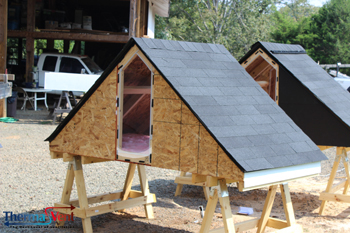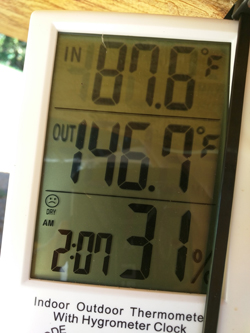We created this model with no venting and a basic 3 tab Asphalt shingle roof. Across America a large number of homes I’d say near 50% do not have any ventilation or very little.  The average temperature in attics on a 90 degree day is over 150 degrees at the peak and 130 degrees at the base. The reason is that there is no way for the hot air to escape, and the Asphalt Shingles on average are 160-170 degrees on the surface once it reaches over 85 degrees outside air temperature. I will show some test samples from this model and you can also down load a weeks’ worth of data in a spread sheet at the bottom of this page. First before we talk about numbers I wanted to talk about the reasons for what we are trying to do with these models. We are trying to explain what the results are and also show why it matters to you and your home. On all the models we have two temperatures, one reading is at the peak of the attic space within inches from the ridge, and the second reading is at the base of the attic. Think about your home and if your house is like most homes in America, the attic insulation would be at the base of your attic above your inside ceiling. For cooling purposes the only temperature that is really important for you is the base attic temperature and that is because your AC unit and insulation will be fighting against that temperature.
The average temperature in attics on a 90 degree day is over 150 degrees at the peak and 130 degrees at the base. The reason is that there is no way for the hot air to escape, and the Asphalt Shingles on average are 160-170 degrees on the surface once it reaches over 85 degrees outside air temperature. I will show some test samples from this model and you can also down load a weeks’ worth of data in a spread sheet at the bottom of this page. First before we talk about numbers I wanted to talk about the reasons for what we are trying to do with these models. We are trying to explain what the results are and also show why it matters to you and your home. On all the models we have two temperatures, one reading is at the peak of the attic space within inches from the ridge, and the second reading is at the base of the attic. Think about your home and if your house is like most homes in America, the attic insulation would be at the base of your attic above your inside ceiling. For cooling purposes the only temperature that is really important for you is the base attic temperature and that is because your AC unit and insulation will be fighting against that temperature.
On 9-8-2015 at 12:36 PM the Outside temperature was 89.5 degree Fahrenheit and this model reached over 140 degrees in the peak of the attic. For the spread sheet if you down load it you will notice that is shows “N/C F” which 140 degrees is the max temperature which the thermometer can read so anything above 140 will show that. The Base of the attic Temperature was 119.3 Fahrenheit at that time. On that day the base attic air temperature rose to 127 degrees at 2:07 PM, and it was 92 degrees outside air temperature. It stayed right at 127 degrees at the base of the attic until about 3:30 PM and stayed over 120 at the base until about 4:30 PM. The peak of the attic did not go under 140 degrees until 3:30 PM and did not drop below 130 degrees in the peak until 5:43 PM. The Base of the attic did not drop below 100 degrees until at 6:44 PM, and the outside air temperature was 84 degrees at that time. The picture to the left shows when it was 87.6 degrees outside air temperature that it was 146.7 degree inside the attic at the peak.
will notice that is shows “N/C F” which 140 degrees is the max temperature which the thermometer can read so anything above 140 will show that. The Base of the attic Temperature was 119.3 Fahrenheit at that time. On that day the base attic air temperature rose to 127 degrees at 2:07 PM, and it was 92 degrees outside air temperature. It stayed right at 127 degrees at the base of the attic until about 3:30 PM and stayed over 120 at the base until about 4:30 PM. The peak of the attic did not go under 140 degrees until 3:30 PM and did not drop below 130 degrees in the peak until 5:43 PM. The Base of the attic did not drop below 100 degrees until at 6:44 PM, and the outside air temperature was 84 degrees at that time. The picture to the left shows when it was 87.6 degrees outside air temperature that it was 146.7 degree inside the attic at the peak.
I know all those numbers are painful to read, it’s a ton of data to think through, So what does it Mean for Me and My Home? This is a great question. Think about if you AC unit is trying to fight against over 120 degrees for longer than 5 hours during the day, if you keep you AC unit set on 75 degrees in the house that means it has to keep a 55 degree difference. The insulation in your attic will help, but it will not be able to stop the direct, convective and radiant heat from coming into you home when you are talking about that amount of high heat.
Think about this, have you ever driven your car in 100 degree temperatures? Did you AC unit have trouble keeping up and cooling you and the inside of your car off? Imagine if the outside temperature was over 120 degrees for over 5 hours, would your AC unit in your car be able to keep up? If it were able to that would be amazing, but either way it would add a lot of stress to your AC unit which will make it not last as long. This is the same idea that is happening with the heat in your attic. Please take a look at the Next Test Case a Real House with Asphalt Shingle Roof No Venting which is similar to this model test case.